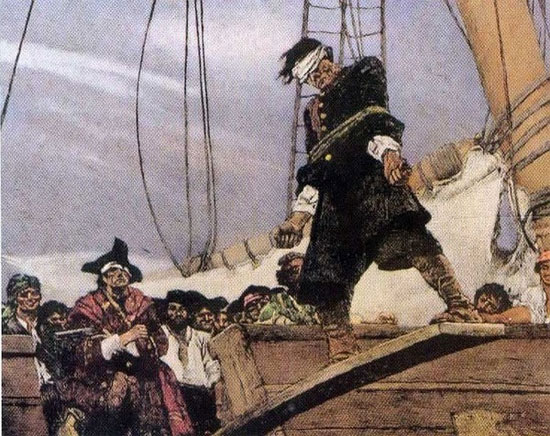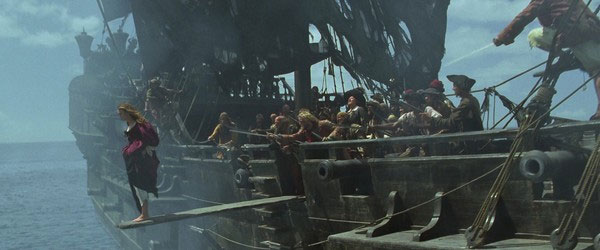The ancient conception of human piracy
Pirates do not like to raise parrots, deliberately chop their feet and hide treasures very poorly . are secrets not everyone knows.
>>>8 surprises about pirates
Referring to pirates, people often think of barbaric images or bloody battles on the sea to plunder wealth. In the minds of most of us, pirates are cruel and cold-blooded people, killing people without hand.
However, the above concepts are not entirely true. Over hundreds of years of history, many facts about piracy have been hidden or overstated by myths, movies, media . Here is a list of myths that we often Meet every mention of pirates.
1. Bloodthirsty pirates and like to kill people with "plank" rituals

Cruel and bloody images of pirates often seen in fictional films.
This is probably the first thing that comes to mind when listening to the word "pirate" . Specifically, most of us believe that pirates like to torture the victim's psychology and take murder as a pastime.

Illustrating the famous "plank" ritual.
However, historical researchers have confirmed that this is purely a rumor. According to the remaining rare records, pirates are not interested in killing people.
Because pirates, wealth, and gold are really what they want. In fact, even in the heyday of pirates (1690-1730), only a few times this ritual was conducted.

Create pirate ritual with 1-0-2 on the screen.
As for the rumor, the main reason why people believe it is the fact that Robert Louis Stevenson's Treasure Island novel in 1883 and JM Barrie's play Peter Pan in 1904. These two famous works referring to the "plank" ritual, thereby causing rumors about them to spread everywhere and become popular beliefs.
2. The infamous pirate often raises parrots on his shoulders
If you're a fan of pirate movies, the images of pirate bosses feeding parrots on their shoulders may have been ingrained in your thoughts. However, if that is the reason why, pirates like to have pets, then you are mistaken.
Not only do not love animals, pirates also use these little animals to earn wealth.

During the seventeenth to early eighteenth centuries, pirates raged across the Atlantic to plunder the wealth. Their paradise is the Caribbean and Central America - where there are a large number of shipping vessels.
At the same time, it is also home to colorful parrots. On the other hand, this period in Europe, the aristocracy (especially in France) initiated the trend of playing pets both poisonously and strangely.

Parrots and rare animals are the hunters of pirates.
For this reason, parrots in the Caribbean become "gold mines" for pirates. According to the remaining documents up to now, pirates often hunt, catch beautiful parrots or monkeys, bring them to the mainland to trade for profit. In particular, they used these animals as a gift of bribery to the nobles in order to escape the prison.

Beautiful parrots will become a great bribe gift for ancient European aristocracy.
3. Good pirates are . legless
We may have become accustomed to the image of pirate-eyed penguins, amputated hands or legless in famous movies on the subject. That makes many people sometimes think: pirates are not injured but only deliberately disguise and do so "cool".

Is this merely a unique fashion?
However, it is not true pirates in history because, pirates are afraid of leglessness like fear of death. The reason is that, at that time, medicine was not developed.
In particular, you will not be able to find a good doctor who joins the army of looters at sea. Therefore, after battles, pirates injured lower limbs will have to remove their legs completely. And the doctor is reluctant to be the cook on the train.

The uncompromising battles made many pirates cut off their feet.
With this temporary treatment, most pirates who have their legs cut will no longer be able to survive because of blood loss or infected wounds. In some surviving cases, they could not continue to act as pirates, but were forced to retire because they could not afford to participate in battles as before.

Even on film, the most notorious pirates never . legless.
4. Pirates often . hide treasures very carefully
Everyone thought that every pirate had a habit of hiding treasure and drawing a map so that he could find it later. However, this is purely a "virtual" concept only in myth.


Maps like this were the target of many people.
In fact, pirates are wasteful people who regularly burn robbery money into alcohol and gambling. They hardly accumulate too much money to bury the treasure.

Instead of hoarding wealth, pirates often spend wildly at pubs and gambling.
Even in history, there are only three cases of records of piracy buried by wealth. That was the case of Francis Drake in 1573, Roche Braziliano in the seventeenth century and Captain William Kidd in 1699.
More significantly, these treasures are easy to find without the need for maps or instructions like in myths. Typically, Captain Kidd's treasure was found by the British on Long Island and used as evidence to convince him to take place as soon as the pirate was alive.

Huge treasures like this . maybe only in movies!
The title has been reset by repository.
- Sex in ancient times
- The process of forming a person from conception to birth
- Poor nutrition slows the process of conception in women
- Develop anti-piracy tool
- Knowing how the ancient Greeks lived
- The wrong scientific knowledge that everyone believes is true
- 'Eye of God' watch the pirates on the sea
- New technology limits digital music piracy
- Ho Chi Minh City: Detection of large software piracy
- How to prevent software piracy?
- Detecting 1,000 human teeth in the walls of ancient buildings in America
- What time should not conceive?
 'Fine laughs' - Scary and painful torture in ancient times
'Fine laughs' - Scary and painful torture in ancient times The sequence of numbers 142857 of the Egyptian pyramids is known as the strangest number in the world - Why?
The sequence of numbers 142857 of the Egyptian pyramids is known as the strangest number in the world - Why? History of the iron
History of the iron What is alum?
What is alum?